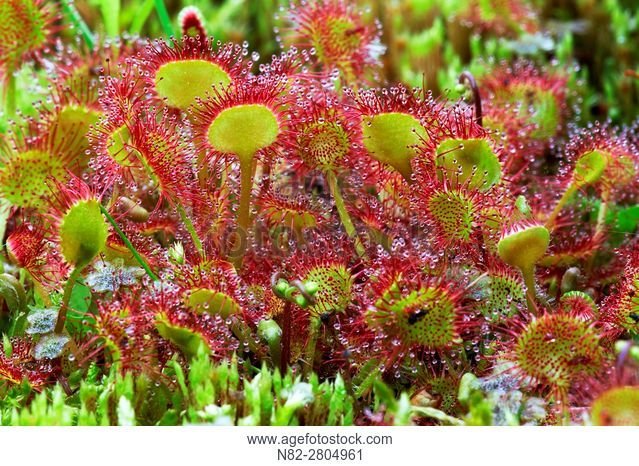Look closely, but be careful when touching it. Beautiful dewdrops on the ends of the plants you see in the photographs below are not as visible. In fact, it is not dew, but it is actually a mucilage (mucus).

Mucilage is a thick and very sticky mucus produced by most plants on the planet: and is also produced by several microorganisms. Some help plants to store water and germinate, and are even used as emergency food storage in some plants. However, on Drosera, mucilage has a unique function.
The leaves of Drosera, the largest genera of carnivorous plants with more than 194 species in the family, are filled with mucus and food. Once the insects settle on these gummy substances, they can not break free. Without freedom, insects can not find food and then die and then become dietary supplements for Drosera that require minerals contained in insect bodies.
Insects will die in two ways. First the insects may drain their own strength while struggling to get rid of Drosera that will eventually be in vain, or in many cases, they will 'drown' in the mucus that controls them first. Mucus envelops them and blocks the insect spiracles (openings in their exoskeleton that allow air to reach the trachea). Deaths like this will mostly occur a maximum of fifteen minutes after the first contact.
Although it looks evil, the common name of Drosera is sundew. The botanical name is from the Greek - Drosos - which means dew. This is a beautiful name for plants that, indeed beautiful, especially when observed through macrophotography like the photographs here.
These plants vary in height, from about 1 cm to one meter in height, depending on the species. Some species of sundew have adapted and can reach up to 3 meters tall. Although they look a bit smooth, but they are very sturdy and can reach the age of more than 50 years.
As genera become specialists, for thousands of years, to take nutrients in the form of insect remnants, sundew pygmy, completely leave the earth nutrients (soil) altogether. This, somewhere along the way, the nitrate reductase enzyme (required to extract nutrients from the soil), is lost or abandoned, although some species still retain the ability to extract nutrients from the soil.
Drosera has gland tentacles crowned with mucus on it and covering their laminae (the flat part of the leaf). There are two glands, one that is involved in catching the magsa, converting and digesting insects. The first is the penduncular, which emits mucus in the first example. This penduncular is also believed to emit a scent that appeals to insects.
This first enzyme will also turn insects into a kind of soup. Secondly, the sessile gland absorbs soup to the plant for its survival, surely after the plant has secreted some enzymes that dissolve prey - only after being converted to soup, insects (or formerly insects) can be absorbed through the leaves and help stimulate growth.
Can this sundew move like his peers in a science fiction movie? The answer is "Yes!" - their tentacles move when in contact with a digestible prey. The tentacles will bend and twist in what the human eye sees as an attempt to push the insect to move to the point where there is a maximal lurking gland.
The scientific name of this reaction is called thigmonasty and (in the plant world), Drosera has a spectacular quick response. Some species bend their tentacles within a tenth of a second from contact. Most of the Drosera species, however, take a few seconds. One or two have additional features - once the prey is caught and dead they will bend their leaves completely around the insect.
The flowers of Drosera are almost always taller than the tentacles that capture the prey of its insects. This was once thought because pollinating insects did not fall prey to them. However, it is now believed that sundew developed this feature simply because higher interest rates would be more likely to attract pollinating insects. The insects that help their pollination can also be their meal.
Genera Drosera is wider than you can imagine. They can be found growing from Alaska to New Zealand. Nonetheless Australia is home to over fifty percent of 194 species, and they are not distributed equally throughout the world, so it is generally not considered a cosmopolitan species because so many regions have no evidence of Drosera ever growing.
They need very specific conditions to develop and that's why they do not get to our house in the same way as the Venus Fly Trap, although some of the more formidable species are often traded. For the most part, the real beauty of Drosera can be found only in its natural habitat.
Reference :
http://www.kuriositas.com/2011/05/drosera-delightful-but-deadly-dewdrops.html
https://en.wikipedia.org/wiki/Drosera
Congratulations! This post has been upvoted from the communal account, @minnowsupport, by h4f from the Minnow Support Project. It's a witness project run by aggroed, ausbitbank, teamsteem, theprophet0, someguy123, neoxian, followbtcnews, and netuoso. The goal is to help Steemit grow by supporting Minnows. Please find us at the Peace, Abundance, and Liberty Network (PALnet) Discord Channel. It's a completely public and open space to all members of the Steemit community who voluntarily choose to be there.
If you would like to delegate to the Minnow Support Project you can do so by clicking on the following links: 50SP, 100SP, 250SP, 500SP, 1000SP, 5000SP.
Be sure to leave at least 50SP undelegated on your account.